As an Amazon Associate I earn from qualifying purchases.
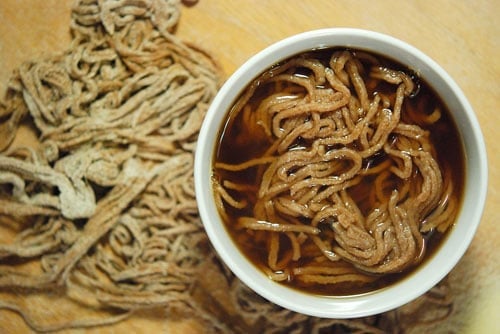
Making stocks and broths are among the core skills of any good cook, and it is a labor or love I embrace wholly. As a hunter, angler and a gardener, I can often make a first-class stock solely with ingredients I’ve grown, caught or shot. This to me is deeply satisfying. Venison stock is one of my mainstays throughout the year.
While some will make a stock without vegetables, I am not among them. They add so much to the final flavor of a stock and can transform it from an additive into a full-fledged broth suitable for drinking on cold days. Incidentally, while I use stock and broth interchangeably, technically a stock is a base and a broth something you can serve on its own; generally a broth is more flavorful and better seasoned than a stock.
Other than the venison, my essentials are: Onions or leeks, carrots, celery, bay leaves, parsley. I will add other herbs as appropriate, most often rosemary and thyme, and sometimes juniper berries. Secret weapon for venison stock: parsnips. Their sweetness brings a lot to the party.
First step is roasting the bones. I like darker, fuller stocks and this is what does it. I roast my deer bones at 400°F for an hour or so, until they are yummy-looking. Incidentally, meat makes better broth, so add some if you can. Secret trick: Save all the gnarly, sinewy bits and trim not even fit for the grinder and roast them along with the bones; don’t include bloodshot meat, though.
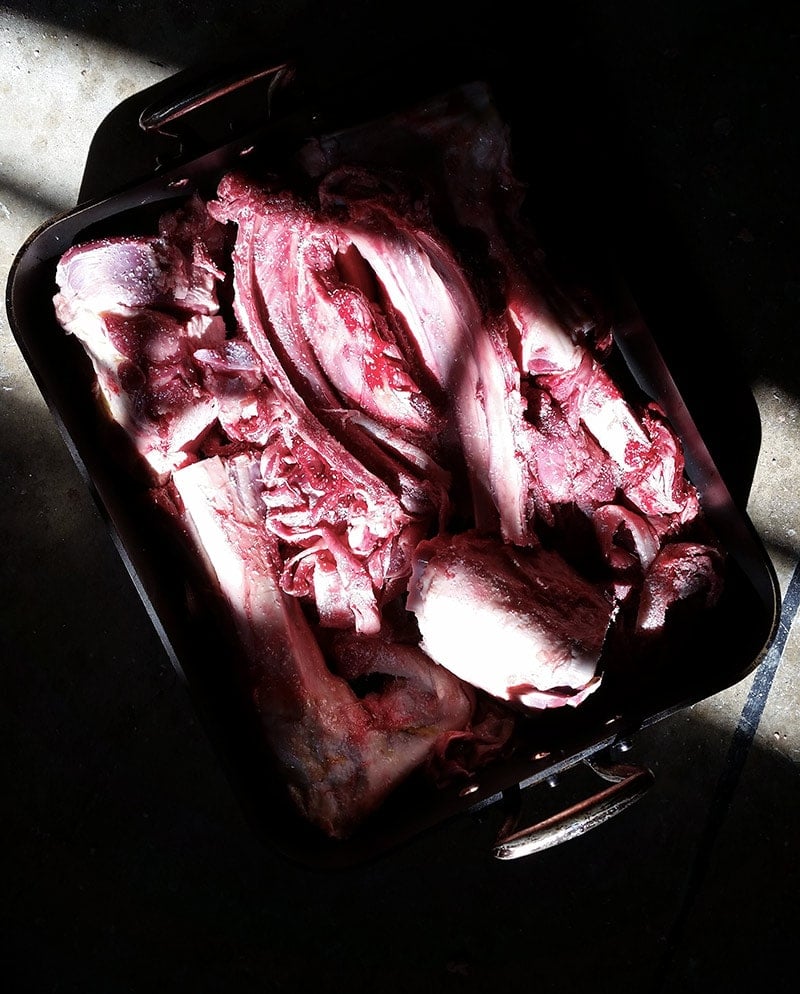
Next cram your bones and trim into the stockpot and cover with cold water by several inches. Cold water will you produce more collagen, and it’s collagen from the joints and cartilage and skin that builds body in your stock by making it thicker than water. You only get this by letting the water heat gradually. Secret trick: Go to the butcher and buy a calf’s or pig’s foot and add it to the pot (don’t roast it, though). It will add a huge amount of body to your broth.
Bring the broth to a boil and skim off any scum that floats to the surface. After the surface is clear, reduce the heat to a bare simmer. You want it to shimmy, not roil, not even bubble too much. A boiled stock will turn cloudy, and the higher temps can extract bitter flavors from the bones. Let it do this for several hours. How long? Up to overnight.
After the meat has infused the water to your liking — 4 hours is a minimum for me — add your veggies, roughly chopped. Remember that old, crappy veggies will not improve by cooking them. That said, the ends of things make great stock, as do onion skins, which will help turn a broth a lovely brown. Stir in your nice vegetables and let it cook for another 90 minutes to 2 hours. No more.
After this, strain everything out. Grab all the big stuff with tongs first, then set a paper towel into a fine mesh sieve. Ladle your venison stock through this into a large bowl or plastic bin. Is all of this necessary? Yes. Unless you want a mucky, cloudy stock. And it is more than aesthetics: The impurities are just that – impure, and add off-flavors to your otherwise wonderful brew.
Once your stock is strained, clean the stockpot or pour the strained liquid into another one. Now you can reduce it if you want to.
This is also the time you can salt the stock. Stock gets saltier the longer you cook it down because salt does not evaporate with the water. So add it close to the end and you will know what you’re getting. If you’re doing demi-glace, don’t salt at all.
All of this takes time, but not a lot of it is active. And the process is comforting to me, as much so as the reward.
Venison Broth
Ingredients
- 4 pounds venison bones, with some meat on them
- 4 tablespoons olive oil
- Salt
- 1 tablespoon crushed juniper berries (optional)
- 2 tablespoons fresh rosemary
- 1 tablespoon crushed black peppercorns
- 1 tablespoon dried thyme
- 4 bay leaves
- 1 medium onion, chopped
- 2 large carrots chopped
- 2 celery sticks chopped
- About 1/2 of a bunch of parsley chopped
Instructions
- Coat the bones with olive oil and salt well, then roast in a 400°F oven until brown. If you can stand it, keep some meat on the bones — trim and shanks are ideal for this. It will make a better broth. Put the bones in a large stockpot. I saw the bones into large pieces with a hacksaw; this lets me fit more bones into the pot, again, making a richer broth. Cover with water and bring to a simmer over medium-high heat.
- Skim the froth that forms on the surface and simmer very gently for at least 4 hours; I let it go overnight. You want the broth to steam and burble a little, not roil.
- Add the remaining ingredients and simmer for another 2 hours.
- Using tongs, grab out all the bones and large bits and discard. Set a paper towel in a fine-mesh sieve that is itself set over another large pot. Ladle the venison broth through the cheesecloth-lined sieve. Discard the dregs in the broth pot, with will be loaded with sediment and other bits.
- Add salt to taste to the clarified broth and pour into quart jars and freeze (or pressure-can — you cannot can broth in boiling water). If you freeze, leave about 2 inches of space at the top of the jar or the jars will crack when the broth freezes. Use within a year.
Notes
Nutrition
Nutrition information is automatically calculated, so should only be used as an approximation.

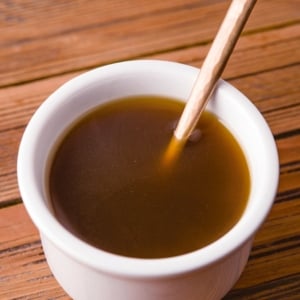
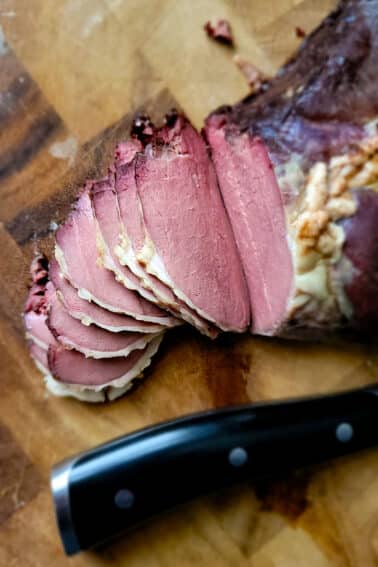
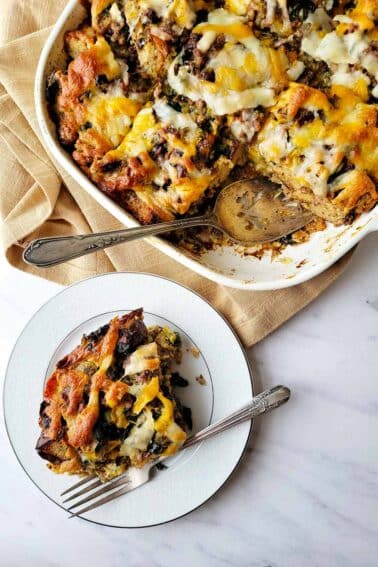
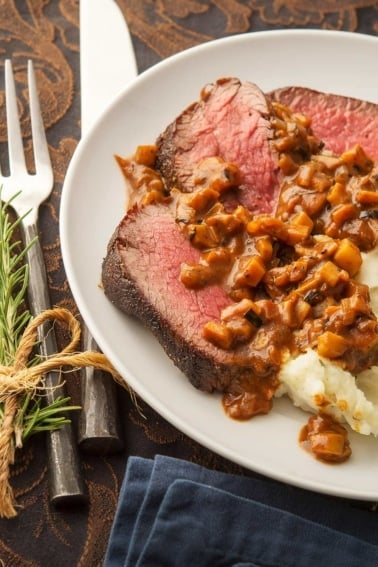
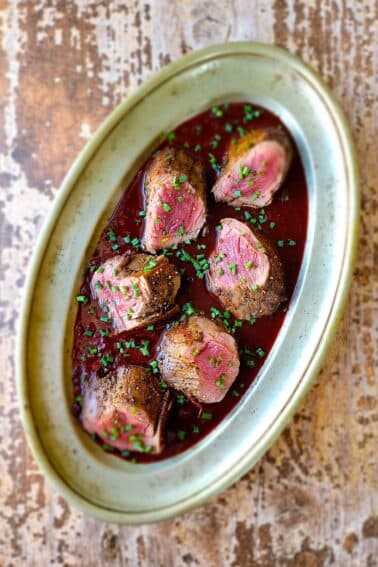
Thank you so much! im getting ready to chop my deer up for jerky and other things and i was wondering about using the bones so nothing goes to waste! i just made my chicken broth and got it canned up so now onto the deer!
Hank, I have about 20lb of venison bones can I multiply your recipe X5 and add to a 40 gal kettle? Also you stated parsnips add sweetness? Do you add whatever veggies you have on hand?
– Austin
Austin: yes, you can scale up. Be mindful of the vegetables. Some won’t work in broth, like the cabbage family, or turnip greens and such.
Hello, would you use a slow cooker for this? If so, would you put it on high heat first and then low heat for the times you mentioned? Thanks!
Alysha: You can. It will take a whole day though.
my stock started to boil and I don’t know how long it’s been boiling for. will it be okay or is it ruined now?
Abby: It’s fine, just probably cloudy. No real way to clear it without making consomme, so just roll with it. It happens, even to me.
Maybe a stupid question. you state to freeze in jars.
Can you freeze in freezer bags (stand upright)?
Richard: Absolutely.
Your recipe does not call for a lid on the stock pot when simmering bones for stock overnight. My concern is the water will evaporate and result in an unpleasant event. Help! “Just cover the bones with water OR cover the bones with several inches of water? ” My stock pot as I write this has all the bones of a good size coastal deer sans the backbone, skull, and pelvis..and has been brought to boil with no apparent residue, fat, debris to be skimmed off. Yes, I followed your advice AND baked the olive oil coated bones at 400* for 2 hour prior.. ..good god, Juniper berries???
Lou: Cover the pot about 90% with a lid. And skip the juniper if you don’t like it. Won’t hurt my feelings.
Hey there! I’m getting ready to try my hand at this Bambi broth! I have a silly question though… do you keep the stock pot covered while simmering?
I’d imagine all the water would boil out if it wasn’t covered, but I’ve looked at so many recipes and none of them state to simmer covered… thanks in advance! Cross your fingers for me!
Sarah: Depends. I usually simmer, or rather steep, the bones and meat overnight, in which case it is 90% covered with the lid. Then, the next morning, I remove the lid, turn up the heat to a proper simmer, then add the vegetables.
Dear Hank,
I made a venison stock, which turned into a thick jelly when cooled down. It indeed made a gallon of stock. It is wonderful! Thank you for the recipe and all the tips.
Penelope
It took me a few years to get there, but I finally have 20 something quarts of this on hand at all times. Sometimes I make the burlier one with the tomato paste from BBM, sometimes the regular. But I am here to tell you, having something of this quality on hand is absolutely priceless. We use it in soups, stews, sauces, and even drink it straight out of a mug like coffee for a collagen boost, or if under the weather, or a bug starts going around, or just for nothing more than shits and giggz.
I just did a batch with antelope leg bones from WY. I never cracked the bones to access the marrow after the initial roasting period. Was that a mistake? I wasn’t sure if the marrow would impart more flavor to the stock? The stock turned out great as is, but figured I’d see if you had any additional guidance. Thanks !
#hankshawforpresident
Peter: Nope, you’re fine. Cracking bones adds something, but it’s not 100% needed.
Thanks for the recipe. Question about the fat layer on top. Do you skim it off or leave it as part of the broth?
Mary: I will typically skim it off if it is venison fat.
Dear Mr. Shaw,
I tried this recipe using Elk femur bones last night. I have always used the left over turkey or chicken bones from a meal and had good success. However, this broth is at a completely different level than previous ones I have made. The broth is exceptionally rich, and complex in a way I cannot describe. I didn’t have all of the “remaining ingredients” – just some carrot ends, onion ends and a sweet potato. But, I am amazed and feel that I can now no longer use store bought beef broth. You’ve ruined me! This is going to have to be the way forward. Thank you for your knowledge and willingness to pass it along. – Josh
I made this broth for the first time last year and absolutely love it! This will definitely be a yearly tradition in our house. That being said-
Are there any bones that I should not use or don’t work as well? I’m mainly asking about the ribs, I don’t feel brave enough to deal with the spine…
Kris: Nope, any bones will do. Although you should always be aware of where your deer came from. In places where Chronic Wasting Disease is present, definitely do not use any bones along the spine, so no vertebrae, hips or skull.
Thank you!
It’s cold here so we left the bones outside for a week, and now I plan to make stock this week. The birds got to some of the meat that was left, so before I use the bones do I need to do anything to sanitize them or will the natural temp of the roasting and simmering do the trick? I’m not trying to make a broth so I could trim off the bone a little better.. but birds are dirty lol
Sasha: Huh. This is a new one. I am not totally sure, but since you are roasting the bones at 400F for a while, and then they will simmer at about 160F for hours, I would imagine a simple rinse with clean water would be OK as a start.
That’s what I was thinking! Thank you – I’m doing this tomorrow so I’ll be back with a review.. unless the bird germs kill me! Kidding!
Could you make vegetable stock, store it, and then when you get some venison turn around and use the vegetable stock instead of water and more vegetables to make the venison stock? Or still add more vegetables? Just curious if it would turn bitter or if anything would go wrong?
Do you can the broth after? Do you have links for what you use or broth for? Thanks!
Jess: You can if you have a pressure canner. And you can use the broth anywhere you would use beef broth. There are probably close to 100 recipes on this site that use it.
Do you split the bones or extract the marrow at all during this process? Could you ectract it after the simmer to be used any other way?
Lucas: No I do not. And I don’t know. I am not a huge fan of deer marrow because the fat in it is incredibly waxy.
How long can you wait to make the broth with the bones after removing the meat from the bones, assuming you keep things refrigerated?
Sam: Maybe a week max.
This stuff is liquid gold. I will use this recipe until I die. Question: any reason not to smoke the bones rather than just roast? Got a shoulder in the smoker and there’s rack space to spare. You the man, Hank.
Scott: Only that a smoked stock is very particular, so you’ll want to mark it as such. I do this with smoked ducks a lot.
Thanks for the reply, Hank! I smoked them, it’s ok, but I wish I hadn’t. Still good, just not what I was expecting. I’ve now made this recipe in the oven, bbq and smoker. Bbq was my favorite. Cheers!
This is a labor of love in the most hands off way. I can’t think of a better way to honor the elk that I harvest than taking the time to use their wonderfully large bones to make the base of so many delicious recipes. My house smells earthy and feels warm as the stock simmers on the stove. Definetly a keeper of a recipe and a process ever hunter should cherish